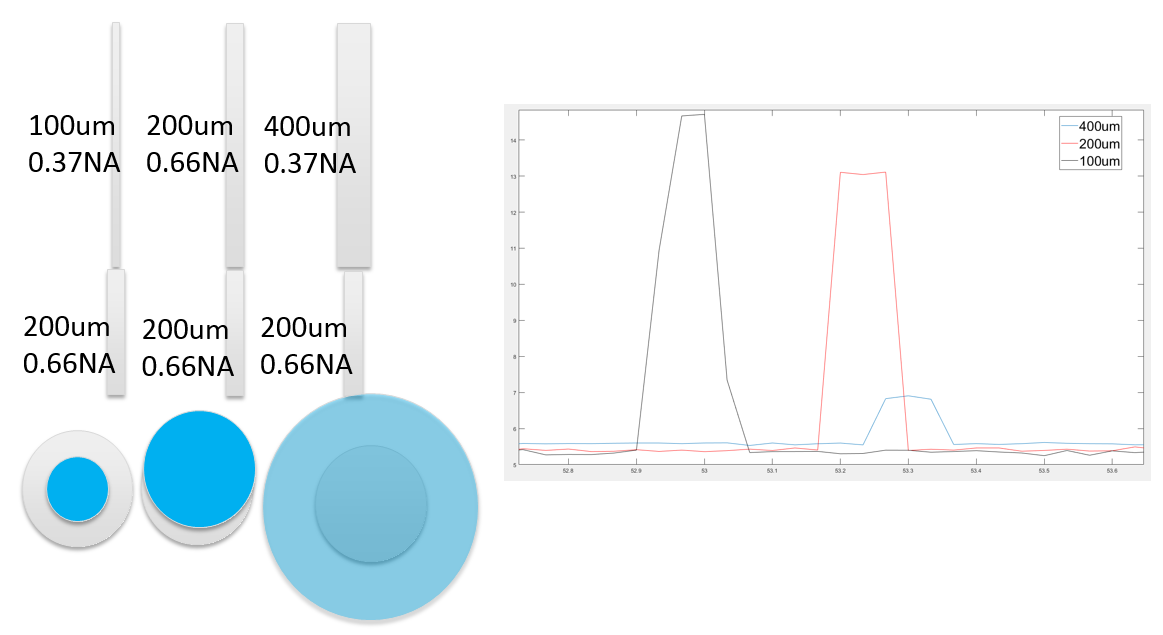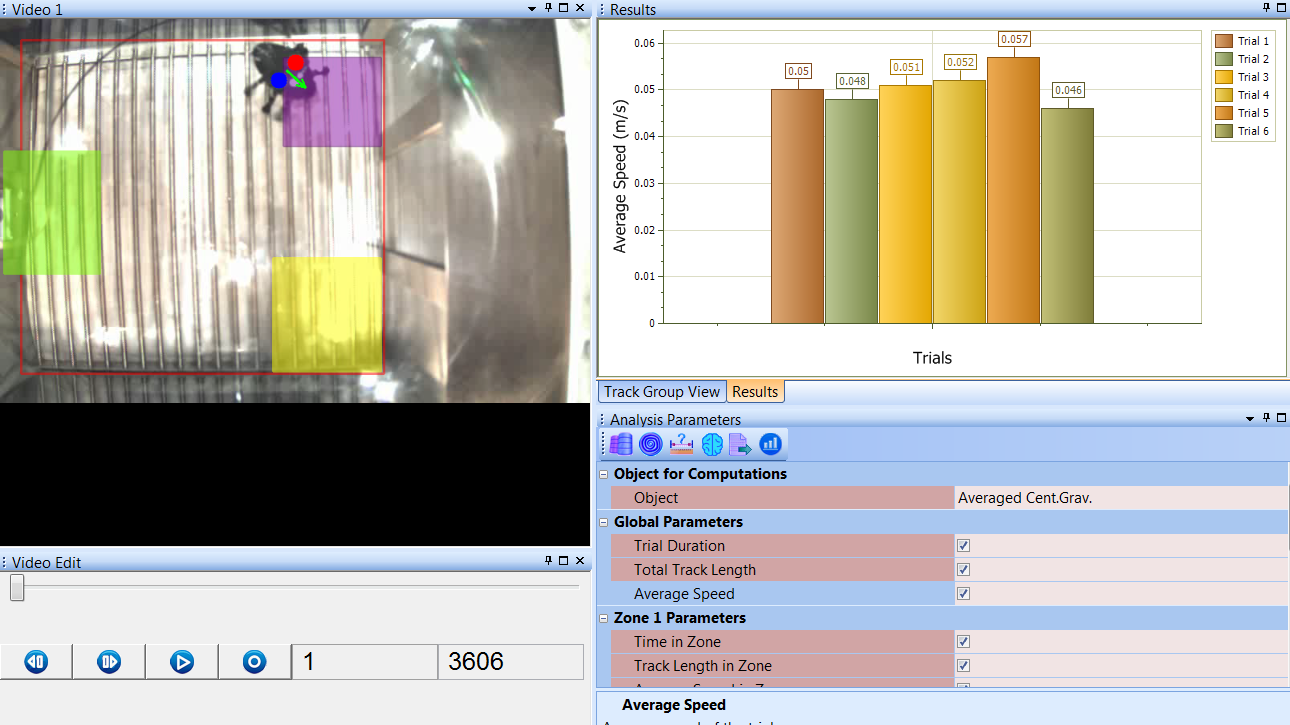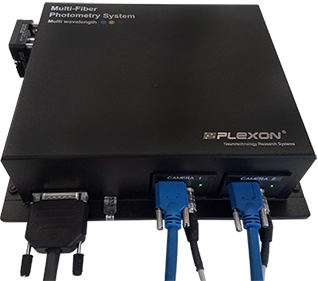Multi-Wavelength Fiber Photometry System
The Multi-Wavelength Fiber Photometry System builds on the technology of the legacy single wavelength photometry system and incorporates new features based on customer feedback.
Plexon’s multi-wavelength fiber photometry system has the capability to deliver multiple wavelengths of excitation light and the ability to detect multiple wavelengths of emitted light. The photometry system offers three excitation ranges centered at 560 nm, 465 nm, and 410 nm and two detection ranges centered at 600 nm and 525 nm. These ranges were chosen to operate with two of the most popular genetically encoded calcium indicators, GCaMP6 and R‑CaMP2.
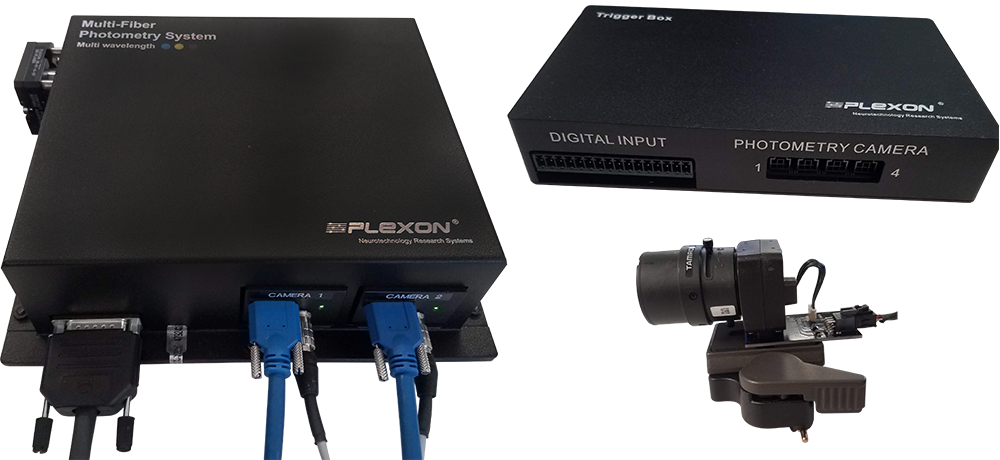
Multi-Wavelength Fiber Photometry System
The Multi-Wavelength Photometry System builds on the technology of the legacy single wavelength photometry system and incorporates new features based on customer feedback.
Plexon’s multi-wavelength fiber photometry system has the capability to deliver multiple wavelengths of excitation light and the ability to detect multiple wavelengths of emitted light. The photometry system offers three excitation ranges centered at 560 nm, 465 nm, and 410 nm and two detection ranges centered at 600 nm and 525 nm. These ranges were chosen to operate with two of the most popular genetically encoded calcium indicators, GCaMP6 and R‑CaMP2.

Multi-Wavelength and Multi-Fiber Photometry
With multi-fiber photometry, the Multi-Wavelength Photometry System builds on the technology of the legacy single wavelength photometry system and incorporates new features based on customer feedback. This camera based system includes three built in LEDs for excitation and two optical sensors which allow for detection of green and red fluorescence simultaneously and a branching patch cable provides the user with the ability to record from multiple brain regions or multiple animals. The system interleaves the 410 nm and 465 nm LEDS and the camera detecting green fluorescence captures light for each of these wavelengths independently, which allows the user to identify the calcium-dependent fluorescence (isosbestic control).
Fiber Photometry System Features
- Record from multiple locations in a single animal or many animals simultaneously with a single system
- Three excitation ranges centered at 560 nm, 465 nm, and 410 nm
- Detect fluorescence at 525 nm and 600 nm using two detection cameras
- Synchronize photometry signals with behavioral events
- Incorporated LED driver
- Integrated with video tracking software

465 nm for selectively activating GCaMP6
560 nm for selectively activating RCaMP2
410 nm for use as an isosbestic control to detect calcium-independent signals

Multi-Wavelength and Multi-Fiber Photometry
With multi-fiber photometry, the Multi-Wavelength Photometry System builds on the technology of the legacy single wavelength photometry system and incorporates new features based on customer feedback. This camera based system includes three built in LEDs for excitation and two optical sensors which allow for detection of green and red fluorescence simultaneously and a branching patch cable provides the user with the ability to record from multiple brain regions or multiple animals. The system interleaves the 410 nm and 465 nm LEDS and the camera detecting green fluorescence captures light for each of these wavelengths independently, which allows the user to identify the calcium-dependent fluorescence (isosbestic control).
Fiber Photometry System Features
- Record from multiple locations in a single animal or many animals simultaneously with a single system
- Three excitation ranges centered at 560 nm, 465 nm, and 410 nm
- Detect fluorescence at 525 nm and 600 nm using two detection cameras
- Synchronize photometry signals with behavioral events
- Incorporated LED driver
- Integrated with video tracking software

465 nm for selectively activating GCaMP6
560 nm for selectively activating RCaMP2
410 nm for use as an isosbestic control to detect calcium-independent signals

Advanced Software for Photometry Signal
Visualization and Analysis
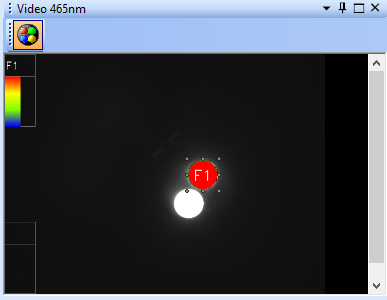
- Visualize raw photometry data and ΔF/F in real-time
- Heatmaps for each individual fiber illustrate changes in fluorescence during recording
- Define photometry events based on ΔF/F threshold crossings and combine with behavioral events to identify if a change in florescence occurs during a specified behavior
- Interface with External Equipment

Advanced Software for Photometry Signal
Visualization and Analysis
- Visualize raw photometry data and ΔF/F in real-time
- Heatmaps for each individual fiber illustrate changes in fluorescence during recording
- Define photometry events based on ΔF/F threshold crossings and combine with behavioral events to identify if a change in florescence occurs during a specified behavior
- Interface with External Equipment
Combined with Behavioral Tracking
Plexon multi-wavelength photometry system includes our behavioral tracking software (CineLyzer). Incorporating photometry into the CineLyzer environment provides the information necessary to make correlations between the photometry signal(s) and the subject’s performance on behavioral tasks.
- Create zones and automatically count the number of behavioral events that occur during recording
- Track speed and position of subject
- Set parameters to identify when a defined behavioral event occurs and the photometry signal crosses a defined threshold.
Fiber Photometry Accessories
Combined with Behavioral Tracking
Plexon's multi-wavelength photometry system includes our behavioral tracking software (CineLyzer). Incorporating photometry into the CineLyzer environment provides the information necessary to make correlations between the photometry signal(s) and the subject’s performance on behavioral tasks.
- Create zones and automatically count the number of behavioral events that occur during recording
- Track speed and position of subject
- Set parameters to identify when a defined behavioral event occurs and the photometry signal crosses a defined threshold.

